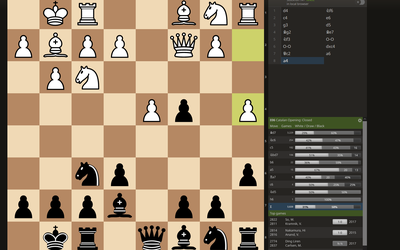
How to develop plans on the board
Struggling with your middlegame strategy? Just follow these two rules!Strategy: What to do when there's nothing to do
We all know to look for checks, captures, and threats in our games. We are always on the lookout for tactics lurking behind every move. But figuring out what to do when there's nothing loose in the position, no weakness to target, and no fireworks on the board is a whole other game. What do you do when there's nothing to do?
Presenting my newest series of lichess studies: Developing plans!
Part I: Talk to your pieces! Best for lichess players 1500-2000.
Part II: Pawns aren't people! Best for lichess players 1900-2400.
This two-part series walks you through two fundamental rules you can follow when you're struggling how to do anything constructive on the chessboard. Let's briefly look at both here, but the true magic lies in going through the studies and doing some hard work!
Developing plans: Talk to your pieces!
First let's consider a boring position with "nothing" going on.
One great way to figure out what to do in this position is to talk to your pieces! By that I mean take each piece (NOT pawn) aside, and ask him or her about their wants and desires on the chessboard.
"What are your goals in life?" you ask the rook on f1. "To dominate the e file and hopefully decisively infiltrate on black's 7th rank!" he responds. Great! You now have a plan in chess. The first move that comes to mind should therefore be Rfe1, staking a claim on the only open file.
"Is there something about this position making you sad?" you ask the rook on a1. "I'm stuck behind my own a2 pawn doing nothing!" he responds. Great! You now have a plan in chess. The first move that comes to mind should therefore be Rae1 (staking a claim on the only open file) or a4, giving the rook more scope on the a file. Before you play Rae1 though, be sure to ask the f1 rook's opinion about that move! "Disgusting," he says. "If my brother goes to e1, how am I supposed to do anything trapped here on f1?" Exactly! We shouldn't be only talking to one piece - but all of the pieces.
"What's your optimal square?" you ask the f3 knight. "I'd love to rule the board from the e5 or c5 outpost!" she responds. Fantastic! You now have a plan in chess. Let's try and trade off all the black pieces that can control the dark squares and eventually plop this knight on e5. Or we can have her jump directly to e5 and prop her up further with a possible f4.
Obviously I'm slightly exaggerating how these conversations would go for effect. But the idea of talking to your pieces and hearing their struggles, desires, feelings, and emotions is a super useful tool to have. Talking to your pieces will naturally lead you to find strategically sound moves in any non-tactical position.
Let's test your newfound knowledge in this interactive quiz!
Developing plans: Pawns aren't people!
Next we'll talk about a more difficult positional idea: "pawns aren't people!" Simply put, this phrase acts as a reminder to put the feelings and desires of your pieces above any concerns for pawn structure or pawn grabbing. Fair warning: handling dynamic positions well is a difficult skill, so this study is tough!
Here, white should be eyeing the central king on d7, black's misplaced rooks on the kingside, and the odd placement of black's queen. Talking to your pieces, you should be hearing your rook, queen, and both rooks begging you to blow open the queenside/center so they have a chance of destroying black's suspicious king.
So what do you do? a5!! A fantastic "pawns aren't people" move. No matter how the tension is resolved, lines will open up on the queenside and center in a way that benefits white's pieces. The a pawn itself is of course completely expendable. As you can see by analyzing the lines presented in the study, there's really no hope for black after all.
Test your newfound understanding in this interactive quiz!
In conclusion
Just a little knowledge goes a long way. Once you start talking to your pieces and appreciating that pawns aren't people, you'll start to play both static and dynamic positions with ease!
I appreciate all likes on this blog post and/or on the study itself. Feel free to follow me on lichess if you are looking for more instructive material. I've already created 13 studies selected for the lichess staff picks page, and I'll be hopefully making more!
If you have any comments about this blog or study, please write in the public chat of the study. I'll be sure to respond there.

